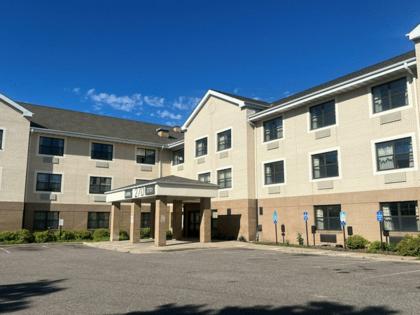A new state program for homeless Minnesotans is off to a rocky start
Published in News & Features
MINNEAPOLIS — Safe places for sick or injured homeless Minnesotans to heal are opening across the Twin Cities, from a single family home in Lakeville to a Brooklyn Center hotel.
“The truth is individuals are too ill to go into a regular shelter,” said Alexia Reed Holtum, executive director of the Duluth-based Bob Tavani House for Medical Respite. “They would often return to the hospital in a worse condition.”
The state recently launched a new program aimed at preventing people who are homeless from cycling back to medical providers or needing hospitalization in the first place. But the Medicaid-reimbursable recuperative care program has faced a bumpy start.
The new state initiative is already undergoing a slew of reforms, with lawmakers recently adding guardrails in hopes of preventing fraud following federal investigations into other social services programs.
“This would have been a news story next year or the year after with the gaps that were there,” said Sen. Jim Abeler, R-Anoka. “I am quite confident now that the program will proceed generally as hoped for.”
The program started in January, a year later than anticipated, and the first provider payment went out in May. So far, 10 people have received respite services, Department of Human Services officials said last week, and three companies have received a total of about $40,000.
But one of those, Brooklyn Center-based Care Chexx, had to pause the respite service in June after city officials determined the operation they were running in a hotel violated city licensing and zoning rules.
While only a few recuperative care organizations have gotten paid so far, the state’s provider directory listed 95 groups that have signed up to do that work as of Wednesday.
Recuperative care had some of the same vulnerabilities as other unlicensed Medicaid-funded programs, such as early autism intervention services and Housing Stabilization Services. State leaders recently moved to shut down the housing aid program amid concerns of widespread fraud among providers that flooded in to do the work.
New recuperative care regulations include provider background studies, surety bonds and compliance training, as well as pre-enrollment risk assessments to ensure the provider has adequate experience, capacity and financial controls. Legislators also added a requirement that the care be provided in a setting that meets habitability inspection requirements, such as cleanliness and having functional heating, cooling and plumbing equipment.
Lawmakers will revisit the regulations they added this year to make sure the program is working how they want, Abeler said, but he believes “we’re at least 80% there.”
Recuperative care isn’t as high-risk as the housing stabilization and autism programs, said Rep. Mohamud Noor, DFL-Minneapolis. He noted respite program providers receive daily flat rates rather than billing for certain units of time, and a medical professional, such as a physician or nurse practitioner, needs to oversee a facility.
Noor said the program will help both people who are homeless and hospitals, and is part of a broader effort to address Minnesota’s struggle with overcrowded emergency rooms.
A 2024 Minnesota Hospital Association study found 1 in 6 days of inpatient care were unnecessary, but patients had nowhere else to recover. And a 2018 study showed for every $1 invested in medical respite, $1.81 is offset in hospital costs.
Farhiya Abdi, a registered nurse, was trying to figure out what to do next in her career when she learned about the recuperative care program.
Her mom’s five-bedroom Lakeville home was mostly empty after her siblings moved out, so opening up the house to serve those in need of medical respite felt like the perfect fit. Abdi and her family transformed the home into a care facility called Maverick Living, including beds with fresh linens, a space for residents to eat three meals a day, security cameras and accessible bathrooms.
It’s one of the few organizations that have received payments for providing the services.
Abdi said she supports lawmakers’ new restrictions, including requiring habitability inspections. And she said having advanced practice providers supervise recuperative care facilities is an important safeguard.
“You have to use the license you’ve worked and gone to school for. You don’t want to put yourself in a predicament where you’d have that license revoked,” Abdi said.
Minnesota is requiring more arduous staffing standards than other states with recuperative care programs, Reed Holtum said. She said the new legislation had a tight deadline for DHS to come out with procedures and rules, and for providers to meet the regulations.
“Nine times out of 10, there’s no personnel assigned, no money in the budget dedicated to it, but the Legislature created this mandate,” said Reed Holtum, who was previously the state’s opioid response program director. “We want best practices. We want it to roll out safely. But we need to do it in a way where there’s coordination between all of these parties involved.”
The Bob Tavani House that she leads has offered respite care since 2018. It is transforming to meet requirements for the new state program, including recently hiring a medical director.
Recuperative care guests come in with a range of illnesses and injuries, including residents who are recovering from pneumonia, broken bones, coronary bypass surgeries and poorly controlled diabetes, said Daisy Braaten, the new medical director. The center helps those guests access medications and physically recover, but also connect with case workers, housing and other resources.
By joining the state program, Reed Holtum hopes the facility — which can only house three or four people — will be able to expand since it can now bill Medicaid for care costs.
“This is coming at a critical juncture for us,” she said, noting the nonprofit had to turn away 44 people in 2024 because it didn’t have enough room.
Getting started has been difficult because the program is so new, Abdi said, and it took her a few months to navigate the state regulations and build relationships with hospitals and insurance providers.
She hopes there will be more information shared with providers and hospitals as the program becomes established.
“All the shelters get full, and winter is going to be around the corner. There are facilities available to help people, but nobody knows about the program,” Abdi said. “We’ve made brochures and tried to advertise ourselves. But I think the state could put more out there.”
More education about the program is also needed as recuperative care facilities seek city approvals to open across the state, Reed Holtum said.
Care Chexx is not the only respite program to run into local issues. Last fall, before the state program launched, Lakeshore Care in Minneapolis sought a city permit to open a 25-bed respite center in the Uptown business district, which was categorized as an emergency overnight homeless shelter under city code.
The project faced delays amid protests from neighboring business owners and residents. The city eventually approved the center, but Lakeshore Care never went forward with opening, said Tina Smith, the center’s program director.
“Every single community has zoning issues,” Reed Holtum said. “We have to be in conversation about our differences of opinions and help humanize each other’s perspectives, so that we can create spaces for people to heal and live.”
------------
—Chris Magan of the Minnesota Star Tribune contributed to this story.
------------
©2025 The Minnesota Star Tribune. Visit at startribune.com. Distributed by Tribune Content Agency, LLC.







Comments